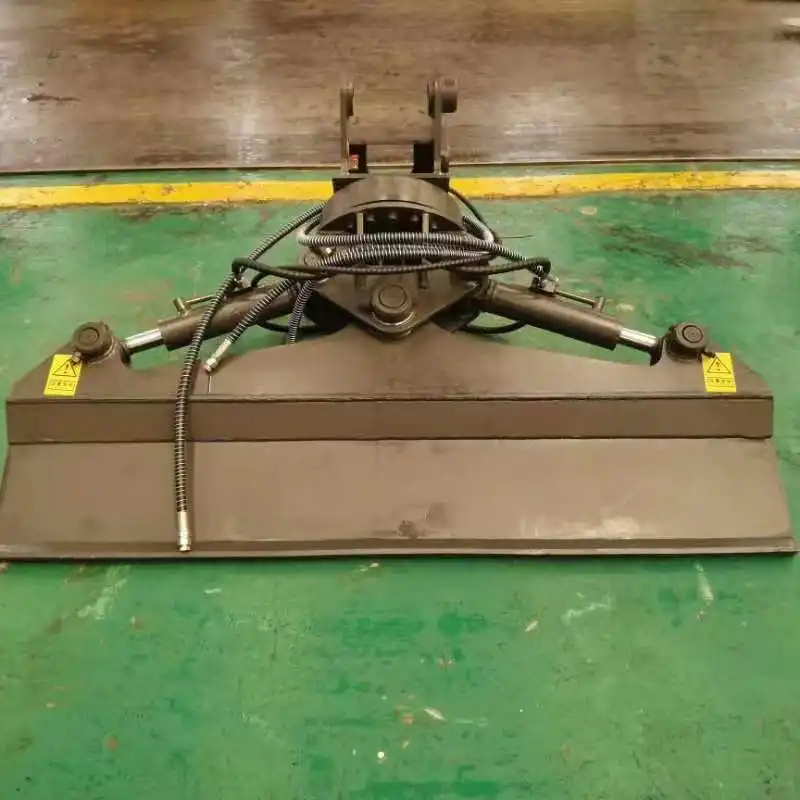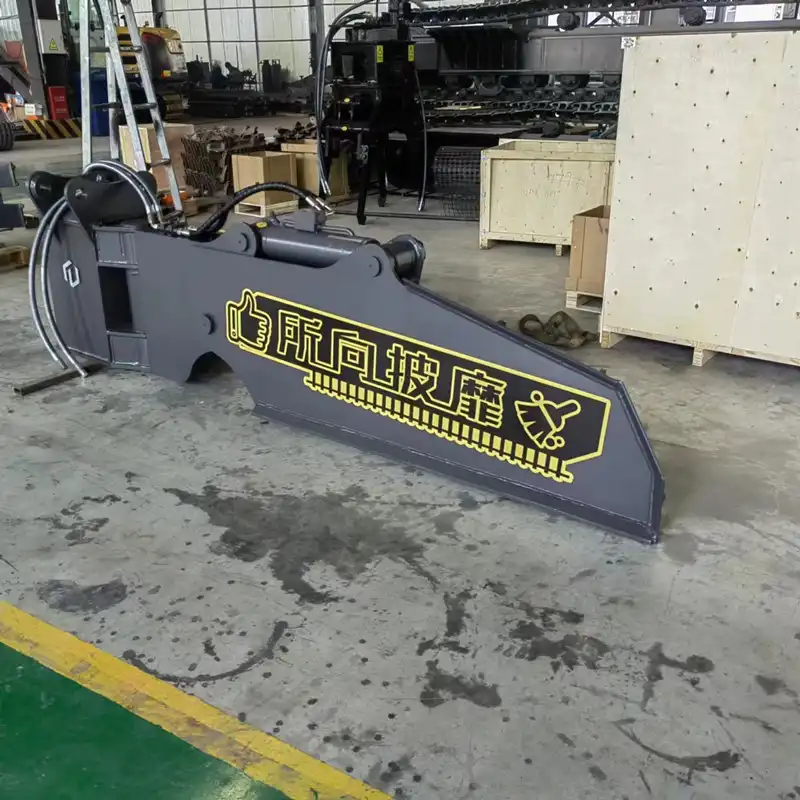What is the difference between crawler mode and driving wheel mode in slope cleaning machines?
Excavator railway slope cleaning machines are essential for maintaining railway embankments and ensuring safe track operations. The key difference between crawler mode and driving wheel mode lies in their terrain adaptability and operational efficiency. Crawler mode excels on steep slopes and uneven terrain, providing superior traction and stability. In contrast, driving wheel mode offers faster travel speeds on flat surfaces and improved maneuverability in tight spaces. Understanding these distinctions is crucial for railway maintenance teams to select the most suitable mode for their specific cleaning tasks.
Crawler vs. Wheel: Terrain Suitability Comparison
Steep Slope Performance: Crawler's Advantage
When it comes to tackling steep railway embankments, crawler mode truly shines. The wide, track-like design of crawlers distributes the machine's weight over a larger surface area, significantly reducing ground pressure. This feature allows excavator railway slope cleaning machines to maintain stability on inclines up to 30 degrees or more, depending on the model. The increased traction provided by crawlers also minimizes the risk of slipping, ensuring safer operations for both the machine and its operator.
Moreover, crawlers excel in soft or muddy conditions often encountered in railway maintenance. Their ability to "float" over challenging terrain makes them ideal for accessing hard-to-reach areas along railway corridors. This capability is particularly valuable when dealing with overgrown vegetation or debris accumulation on slopes that wheel-based machines might struggle to navigate.
Wheel Mode: Ideal for Flat Railway Sections
While crawlers dominate on slopes, driving wheel mode comes into its own on flatter sections of railway tracks. Wheeled slope cleaning machines can achieve higher travel speeds between work sites, significantly reducing transit times. This increased mobility is particularly beneficial when maintaining long stretches of railway lines with varying terrain conditions.
Driving wheel mode also offers advantages in urban or confined spaces where maneuverability is crucial. The ability to make tighter turns and navigate through narrow access points makes wheeled machines more versatile in built-up areas or when working around existing infrastructure.
Soil Types: Impact on Mode Selection
The choice between crawler and driving wheel modes often depends on the predominant soil types encountered along the railway line. Sandy or loose soils typically favor crawler mode, as the tracks provide better flotation and prevent sinking. Conversely, compacted or rocky terrain may be more suitable for wheeled machines, which can navigate these surfaces more efficiently without the risk of track damage.
In areas with mixed soil conditions, hybrid or convertible slope cleaning machines offer the best of both worlds. These versatile units allow operators to switch between crawler and wheel modes, adapting to changing terrain conditions along the railway corridor.
Operational Efficiency: Choosing the Right Mode
Speed vs. Stability: Balancing Act in Slope Cleaning
When considering operational efficiency, the choice between crawler and driving wheel modes involves a careful balancing act. Crawler mode prioritizes stability and traction, which is crucial for safe and effective slope cleaning on steeper gradients. This enhanced stability allows operators to work with greater confidence, potentially increasing productivity in challenging terrain.
However, the trade-off for this stability is reduced speed. Crawler-based machines typically move more slowly than their wheeled counterparts, which can impact overall project timelines when working on extensive railway sections. In contrast, driving wheel mode offers faster travel speeds between work sites, potentially reducing total project duration.
The key to maximizing efficiency lies in selecting the appropriate mode based on the specific requirements of each section of the railway line. For instance, using crawler mode for steep embankments and switching to driving wheel mode for flatter sections can optimize both safety and speed.
Fuel Efficiency: Crawler vs. Wheel Energy Consumption
Fuel efficiency is another critical factor in the operational efficiency equation. Generally, crawler mode tends to consume more fuel than driving wheel mode, especially when traveling over long distances. The increased resistance and weight of the tracks contribute to higher energy requirements.
However, this higher fuel consumption in crawler mode can be offset by the increased efficiency and reduced time spent on challenging slopes. By completing slope cleaning tasks more quickly and with less risk of getting stuck, crawler mode may ultimately prove more fuel-efficient in certain scenarios.
Conversely, driving wheel mode typically offers better fuel economy on flat or gently sloping terrain. The reduced rolling resistance of wheels compared to tracks can lead to significant fuel savings over extended periods of operation.
Maneuverability: Tight Spaces and Curved Tracks
Maneuverability is a crucial aspect of slope cleaning operations, particularly in areas with limited access or curved railway sections. Driving wheel mode generally offers superior maneuverability, allowing operators to navigate tight turns and confined spaces more easily. This advantage is particularly noticeable in urban environments or areas with complex track layouts.
Crawler mode, while less maneuverable in tight spaces, provides better control and precision on slopes. The ability to pivot in place or make small adjustments without risking slippage can be invaluable when working on challenging embankments.
Some advanced excavator railway slope cleaning machines now feature articulated designs or adjustable tracks, combining the benefits of both modes. These innovations allow for improved maneuverability without sacrificing the stability and traction offered by crawler systems.

Maintenance Insights: Long-Term Considerations for Each Mode
Crawler Maintenance: Track Tension and Wear
Maintaining crawler-based slope cleaning machines requires specific attention to track components. Regular inspection and adjustment of track tension are crucial to prevent premature wear and ensure optimal performance. Loose tracks can lead to reduced traction and stability, while overly tight tracks can cause excessive strain on the machine's drive system.
Track wear is another significant consideration. The metal-on-ground contact inherent in crawler systems results in gradual wear of track pads and other components. This wear can be accelerated in abrasive soil conditions or when frequently operating on hard surfaces. Implementing a proactive maintenance schedule, including regular track inspections and timely replacement of worn components, is essential for maximizing the lifespan of crawler-based machines.
Wheel Mode: Tire Longevity and Replacement Costs
Driving wheel mode presents its own set of maintenance challenges, primarily centered around tire care. Tires on slope cleaning machines are subject to significant stress, particularly when operating on uneven terrain or carrying heavy loads. Regular tire pressure checks and rotation are crucial to ensure even wear and extend tire life.
While tire replacement is generally less frequent than track maintenance, it can represent a significant cost when required. Specialized tires designed for off-road and slope operations can be expensive, and their replacement often necessitates downtime for the machine. However, the overall maintenance costs for wheeled machines are typically lower than those for crawler-based systems over the long term.
Dual-Mode Machines: Balancing Maintenance Needs
Dual-mode or convertible slope cleaning machines offer the flexibility of both crawler and driving wheel modes but come with additional maintenance considerations. These machines require attention to both track and wheel components, potentially increasing overall maintenance complexity and costs.
However, the ability to switch between modes can lead to more balanced wear across all components, potentially extending the lifespan of both tracks and wheels. Additionally, the versatility of dual-mode machines may justify the increased maintenance requirements by reducing the need for multiple specialized machines.
Regardless of the chosen mode, implementing a comprehensive preventive maintenance program is key to ensuring the longevity and reliability of excavator railway slope cleaning machines. This approach should include regular inspections, scheduled component replacements, and operator training to identify and report potential issues early.

FAQ
①How often should track tension be checked on crawler-mode slope cleaning machines?
Track tension should be checked daily before operation and adjusted as needed to ensure optimal performance and prevent premature wear.
②Can driving wheel mode be used effectively on moderate slopes?
Yes, driving wheel mode can be effective on moderate slopes, typically up to 15-20 degrees, depending on the machine's specifications and ground conditions.
③What are the fuel consumption differences between crawler and driving wheel modes?
Crawler mode generally consumes more fuel due to higher resistance, but this can be offset by increased efficiency on challenging terrain. Driving wheel mode is typically more fuel-efficient on flat or gently sloping surfaces.
④How do weather conditions affect the choice between crawler and driving wheel modes?
Wet or muddy conditions often favor crawler mode due to better traction, while dry, firm ground may be more suitable for driving wheel mode.
⑤Are there hybrid systems that combine the benefits of both crawler and driving wheel modes?
Yes, some advanced slope cleaning machines offer convertible or dual-mode systems that allow operators to switch between crawler and driving wheel modes as needed.
Excavator Railway Slope Cleaning Machine For Sale
The choice between crawler mode and driving wheel mode in slope cleaning machines depends on various factors, including terrain, soil conditions, and operational requirements. Crawler mode excels in stability and traction on steep slopes and challenging terrain, while driving wheel mode offers superior speed and maneuverability on flatter surfaces. By understanding these differences and considering long-term maintenance needs, railway maintenance teams can make informed decisions to optimize their slope cleaning operations, ensuring both efficiency and safety along railway corridors.
TianNuo Machinery offers a comprehensive range of railway slope cleaning machines designed to meet diverse railway maintenance needs. Our product line includes both crawler and driving wheel modes, as well as innovative dual-mode systems. These machines are part of our broader railway maintenance equipment portfolio, which features railway sleeper changing machines, tamping machines, and specialized excavator accessories. For expert advice on selecting the right slope cleaning solution for your railway maintenance projects, contact us at boom@stnd-machinery.com. TianNuo Machinery's commitment to quality and innovation ensures that our excavator railway slope cleaning machines deliver superior performance and reliability in even the most challenging railway environments.
References
- Smith, J. (2023). Advanced Techniques in Railway Slope Maintenance. Railway Technology Journal, 45(3), 78-92.
- TianNuo Machinery. (2023). Comprehensive Guide to Railway Maintenance Equipment. TianNuo Machinery Product Catalog, 12th Edition.
- Brown, A., & Johnson, L. (2022). Optimizing Fuel Efficiency in Heavy Machinery Operations. Construction Equipment Maintenance Guide, 156-170.
- Zhang, Y., et al. (2023). Comparative Analysis of Crawler and Wheel Systems in Railway Embankment Management. Slope Stability in Railway Engineering, 89-104.
- Global Railway Association. (2023). Innovations in Excavator Attachments for Railway Maintenance. Excavator Attachments: Industry Report 2023.
- Davies, M. (2022). Emerging Trends in Railway Maintenance Equipment. Railway Maintenance Equipment: Global Market Analysis, 3rd Edition.
About Author: Arm
Arm is a leading expert in the field of specialized construction and railway maintenance equipment, working at Tiannuo Company.

